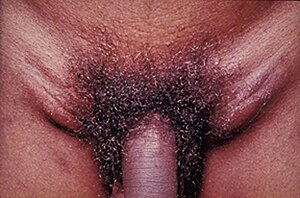Lymphogranuloma venereum
| Lymphogranuloma venereum | |
|---|---|
 |
|
| Lymphogranuloma venereum in a young adult who experienced acute onset of tender, enlarged lymph nodes in both groins. | |
| Classification and external resources | |
| Specialty | infectious disease |
| ICD-10 | A55 |
| ICD-9-CM | 099.1 |
| DiseasesDB | 29101 |
| MedlinePlus | 000634 |
| eMedicine | emerg/304 med/1356 derm/617 |
| MeSH | D008219 |
Lymphogranuloma venereum (LGV) (also known as "Climatic bubo", "Durand–Nicolas–Favre disease", "Poradenitis inguinale", and "Strumous bubo") is a sexually transmitted disease caused by the invasive serovars L1, L2, L2a or L3 of Chlamydia trachomatis.
LGV is primarily an infection of lymphatics and lymph nodes. Chlamydia trachomatis is the bacterium responsible for LGV. It gains entrance through breaks in the skin, or it can cross the epithelial cell layer of mucous membranes. The organism travels from the site of inoculation down the lymphatic channels to multiply within mononuclear phagocytes of the lymph nodes it passes.
In developed nations, it was considered rare before 2003. However, a recent outbreak in the Netherlands among gay men has led to an increase of LGV in Europe and the United States. A majority of these patients are HIV co-infected.
LGV was first described by Wallace in 1833 and again by Durand, Nicolas, and Favre in 1913. Since the 2004 Dutch outbreak many additional cases have been reported, leading to greater surveillance. Soon after the initial Dutch report, national and international health authorities launched warning initiatives and multiple LGV cases were identified in several more European countries (Belgium, France, the UK, Germany, Sweden, Italy and Switzerland) and the US and Canada. All cases reported in Amsterdam and France and a considerable percentage of LGV infections in the UK and Germany were caused by a newly discovered Chlamydia variant, L2b, a.k.a. the Amsterdam variant. The L2b variant could be traced back and was isolated from anal swabs of men who have sex with men (MSM) who visited the STI city clinic of San Francisco in 1981. This finding suggests that the recent LGV outbreak among MSM in industrialised countries is a slowly evolving epidemic. The L2b serovar has also been identified in Australia.
The clinical manifestation of LGV depends on the site of entry of the infectious organism (the sex contact site) and the stage of disease progression.
LGV may begin as a self-limited painless genital ulcer that occurs at the contact site 3–12 days after infection. Women rarely notice a primary infection because the initial ulceration where the organism penetrates the mucosal layer is often located out of sight, in the vaginal wall. In men fewer than 1/3 of those infected notice the first signs of LGV. This primary stage heals in a few days. Erythema nodosum occurs in 10% of cases.
...
Wikipedia
